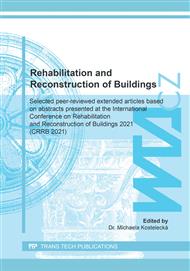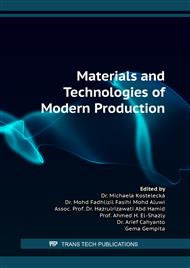[1]
Electrophysical properties of composites based on the epoxy resin and expanded graphite / O. G. Sirenko, S. M. Makhno, O. M. Lisova [et al.] // Chemistry, Physics and Technology of Surface. – 2018. – Vol. 9. – No 4. – P. 442-446.
Google Scholar
[2]
J. Cao, D.D.L. Chung. Colloidal graphite as an admixture in cement and as a coating on cement for electromagnetic interference shielding. Cement and Concrete Research, Volume 33, Issue 11, November 2003, Pages 1737-1740 doi.org/10.1016/S0008-8846(03)00152-2.
DOI: 10.1016/s0008-8846(03)00152-2
Google Scholar
[3]
R. Kaur, N.C. Kothiyal. Comparative effects of sterically stabilized functionalized carbon nanotubes and graphene oxide as reinforcing agent on physical and mechanical properties and electrical resistivity of cement nanocomposites. Construction and Building Materials, Volume 202, 30 March 2019, Pages 121-138.
DOI: 10.1016/j.conbuildmat.2018.12.220
Google Scholar
[4]
H. Dehghanpour, K. Yilmaz, M. Ipek. Evaluation of recycled nano carbon black and waste erosion wires in electrically conductive concretes / Construction and Building Materials, Vol 221, 2019, P/. 109-121.
DOI: 10.1016/j.conbuildmat.2019.06.025
Google Scholar
[5]
M. Mar Barbero-Barrera, N. Flores Medina, C.Guardia-Martín. Influence of the addition of waste graphite powder on the physical and microstructural performance of hydraulic lime pastes. Construction and Building Materials, Volume 149, 15 September 2017, Pages 599-611.
DOI: 10.1016/j.conbuildmat.2017.05.156
Google Scholar
[6]
N. Flores Medina, M. Mar Barbero-Barrer, R. Bustamante. Improvement of the properties of gypsum-based composites with recycled isostatic graphite powder from the milling production of molds for Electrical Discharge Machining (EDM) used as a new filler. Construction and Building Materials, Volume 107, 15 March 2016, Pages 17-27.
DOI: 10.1016/j.conbuildmat.2015.12.194
Google Scholar
[7]
N. Flores Medina, M. Mar Barbero-Barrer, F. Jové-Sandoval. Improvement of the mechanical and physical properties of cement pastes and mortars through the addition isostatic graphite. Construction and Building Materials, Volume 189, 20 November 2018, Pages 898-905.
DOI: 10.1016/j.conbuildmat.2018.09.055
Google Scholar
[8]
Zhang, B.; Yang, H.; Xu, T.; Tang, W.; Cui, H. Mechanical and Thermo-Physical Performances of Gypsum-Based PCM Composite Materials Reinforced with Carbon Fiber. Appl. Sci. 2021, 11, 468. https://doi.org/10.3390/app11020468.
DOI: 10.3390/app11020468
Google Scholar
[9]
B. Zhang, Y. Tian, X. Jin, Tommy Y. Lo, H. Cui. Thermal and Mechanical Properties of Expanded Graphite/Paraffin Gypsum-Based Composite Material Reinforced by Carbon Fiber / Materials 2018, 11, 2205;.
DOI: 10.3390/ma11112205
Google Scholar
[10]
Lemeshev M.S. Conductive metal-saturated concretes for polyfunctional purposes // Actual problems of architecture, construction, energy efficiency and ecology. 2016 / Federal State Budgetary Educational Institution of Higher Education Tyumen Industrial University,. - Tyumen: Tyumen Industrial University, 2016. – Р. 242-247 (In Russian).
DOI: 10.33920/med-01-2209-08
Google Scholar
[11]
Yakovlev G., Pervushin G., Smirnova O., Begunova E., Saidova Z. The Electrical Conductivity of Fluoroanhydrite Compositions Modified at the Nanoscale Level with Carbon Black. Environmental and Climate Technologies. 2020; 24(1): 706-717. https://doi.org/10.2478/rtuect-2020-0044.
DOI: 10.2478/rtuect-2020-0044
Google Scholar
[12]
Yakovlev G.I., Begunova E.V., Drochytka R., Melichar J., Pudov I.A., Saidova Z.S. The Influence of Activated Dispersed Additives on Electrical Conductivity of Anhydrite Compositions. SSP 2021; 321:51–7. https://doi.org/10.4028/www.scientific.net/ssp.321.51.
DOI: 10.4028/www.scientific.net/ssp.321.51
Google Scholar
[13]
High-strength fluoroanhydrite binder, a method of obtaining high-strength fluoroanhydrite binder and compositions based on it (options) // Invention patent 2723788 C1, 17.06.2020. Application № 2019109289 29.03.2019 / Grakhov V.P., Pervushin G.N., Kalabina D.A. (In Russian).
Google Scholar
[14]
Kalabina D.A., Yakovlev G.I., Kuzmina N.V. Shrinkage-free fluoroanhydrite compositions for flooring // Izvestia KGASU. 2021. № 1 (55). Р. 24–38.
DOI: 10.52409/20731523_2021_1_24
Google Scholar
[15]
Smirnov A.V., Smirnova V.A. Patent 2075438 RF MPK С01В 31/04, Н05В 6/64. Expanded graphite production method / 1997. (In Russian).
Google Scholar
[16]
Kodolov V.I., Trineeva V.V., Mustakimov R.V. and other Patent 2715655 RF IPC C2. Method of obtaining metal/carbon nanocomposites / 2020. Bulletin № 7. (In Russian).
Google Scholar



